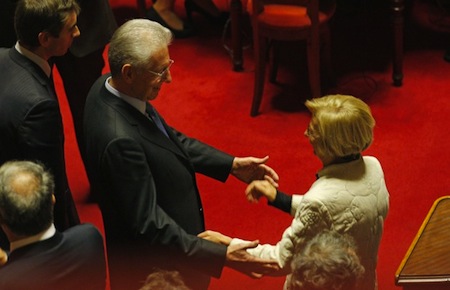With the failure of centrosinistra (center-left) leader Pier Luigi Bersani to form a government after a week of talks, Italian president Giorgio Napolitano now faces a tough 24 hours of consultations with the other key players in the Italian parliament.![]()
The path now becomes perilous — for Napolitano, above all, who remains just about the only respected public official left in Italy:
- Of course, as I noted earlier today, upon further consultation with the various players on Friday, Napolitano could give Bersani, the leader of the Partito Democratico (PD, Democratic Party), more time to cobble together a government. That doesn’t seem so incredibly likely to succeed.
- Napolitano could also appoint Bersani as prime minister to try to win a vote of confidence in the upper house of the Senato, essentially daring Silvio Berlusconi’s centrodestra (center-right) coalition to reject him, though it seems unlikely that Napolitano would do so if there’s a chance Bersani would lose the vote. If Bersani loses, he’ll be left as a discredited caretaker prime minister, and Napolitano will have suffered a political defeat as well, limiting his future maneuverability.
- Another option is simply to leave prime minister Mario Monti (pictured above shaking hands with Italian senator Emma Bonino) in place as a pro forma caretaker — this is the ‘Belgian’ option: a parliament with no real government. That could well cause Italian bond yields to rise or otherwise call into question Italy’s capability for long-term reform. That’s especially true if you think the eurozone is primarily a political crisis rather than an economic one.
Another option, of course, would be for Napolitano to appoint a new technocratic prime minister, though that carries risks as well, especially coming after the political rejection of Monti’s pro-reform, centrist coalition in the February elections. Monti was appointed as a technocratic prime minister in November 2011 with the support of both the PD and Berlusconi’s Popolo della Libertà (PdL, People of Freedom). In late 2011 and early 2012, Monti’s government instituted reforms to reduce tax evasion, increased taxes, pension reform that reduces early retirement, and he instituted some modest labor reforms as well, though they’ve not had the sweeping effect Italy’s economy may need to revitalize its labor market.
But Monti’s government stalled and Italy went to early elections in February when Berlusconi and the PdL pulled its support from Monti’s government, and Berlusconi and Beppe Grillo, leading the protest Movimento 5 Stelle (M5S, the Five Star Movement) actively ran against Monti’s reforms and attacked Monti as little more than an errand-boy for Brussels and Berlin.
So if neither Bersani nor Monti appear workable choices, to whom could Napolitano turn in the event of yet another technocratic government? Such a government would have a very limited mandate for, say, electing a new president (which the new parliament must accomplish in May 2013 before new snap elections could even be held), carrying out the execution of Italy’s 2013 budget and perhaps even overseeing a change in the election law.
Here are seven potential candidates to keep an eye on in the days ahead:
1. Ignazio Visco. The current governor of the Banca d’Italia since October 2011, Visco succeeded Mario Draghi, who is now the head of the European Central Bank.

A longtime central bank bureaucrat, Visco would be a caretaker along the lines of Ciampi, though it’s unclear that the Italian electorate’s mood quite aligns with the appointment of the second economist in three years to lead an unelected government.
His ties to Draghi, moreover, would leave him arguably more open to charges of being a eurocrat puppet more than even Monti, who originally began his technocratic government with much more widespread support and popularity.
Fabrizio Saccomanni, an economist and the director-general of the Banca d’Italia since 2006, has also been mentioned as a potential candidate, though it’s hard to see how he could command much more popular support than Visco or Monti.
2. Emma Bonino. Bonino, an Italian senator since 2008, is one of the more compelling choices Napolitano could make. Though she’s a longtime fixture in Italian politics, she’s long been a voice for progressive reform — and she would also be the first woman to lead an Italian government.

First elected to the Italian parliament in 1976 from the Radical Party, Bonino has long blended economic liberalism of the right and social humanism of the left. In the 1970s, she championed the legalization of abortion in Italy, which became law in 1978 and ratified by a 1981 referendum. In the 1980s, she supported a referendum on nuclear energy, which resulted in Italy’s rejection of nuclear power in 1987, again by referendum.
Bonino served as Italy’s minister for international trade in Romano Prodi’s center-left government from 2006 to 2008, but her real mark recently has been in Europe: a member of the European Parliament, Bonino has been a champion of women’s rights, the legalization of drugs, same-sex marriage, religious freedom, as well as against the death penalty and female genital mutilation. She served as Italy’s member of the European Commission from 1994 to 1999, overseeing consumer policy, health and food safety, fisheries and humanitarian affairs.
For what it’s worth (not much, since the Italian president isn’t elected directly), Bonino is a current slight favorite among Italians to succeed Napolitano — a mid-March SWG poll shows her leading with 14% support, to 9% each for Berlusconi, Monti and Prodi, 8% for playwright Dario Fo (a Five Star supporter) and 7% in favor of a second term for Napolitano (though he’s said he doesn’t wish to stand for reelection).
3. Gustavo Zagrebelsky. A constitutional lawyer, Zagrebelsky was a judge of the Italian Constitutional Court from 1995 to 2004, serving from January to September 2004 as the court’s president.

Of Russian origin, Zagrebelsky’s brother Vladimiro serves on the European Court of Human Rights.
He’s currently a professor of constitutional law in Turin, and he’s also, like Bonino, been a hot property in discussions over who should succeed Napolitano.
If the president wants to appoint a technocratic figure associated with an Italian institution that’s not primarily financial in nature, Zagrebelsky would not be the worst person Napolitano could choose, as Zagrebelsky has often spoken often out about Italian democracy in theoretical and in more concrete terms in the decade since leaving the court — he gave a thoughtful interview to La Stampa, in fact, earlier this week. As such, he’s probably the technocratic (or presidential) possibility most likely to win Five Star support.
4. Stefano Rodotà. A former deputy first elected as an independent associated with the old Italian Communist Party, Rodotà was part of the moderate leftist opposition in the 1980s against what had become a five-party oligarchy (‘pentpartito‘) dominated by the Christian Democrats and Socialists.

He was among the first leaders of the Democratic Party of the Left that emerged from the post-Cold War Italian Communists and that is the predecessor to today’s PD.
Rodotà served as vice president of the Camera dei Deputati (House of Deputies), Italy’s lower house in 1992, and he has served in the European Parliament as well. From 1997 to 2005, he served as the first president of Italy’s authority for the protection of personal data, and he’s been a leading voice on electronic privacy rights throughout the European Union in the past decade. Before entering public life, he was a legal scholar based in Rome.
Although he’ll turn 80 in May, he’ll also be a likely candidate mentioned to succeed Napolitano as well.
5. Pietro Grasso. The newly elected president of the Senato, Italy’s upper house, Grasso is a political newcomer who won his position when Monti’s supporters and legislators from the Five Star Movement abstained from the vote, thereby allowing Grasso to win solely on the strength of the centrosinistra — that’s not quite a bright endorsement from the Five Star senators, but Grasso’s certainly much more amenable than Bersani preferred candidate, longtime senator Anna Finocchiaro.

Although Grillo has ruled out a potential Grasso-led government, he might be able to unite just enough Five Star, centrist and center-left allies to succeed where Bersani has failed — after all, unlike Bersani, he’s already survived one of the few votes of the new parliament.
Grasso is a former judge with a long history of anti-mafia credentials, which also likely endeared him to many Five Star parliamentarians, and from 2005 to 2012, he was Italy’s chief national anti-mafia prosecutor. During his tenure, he oversaw the capture of one of Italy’s most wanted mafia fugitives,Bernardo Provenzano, in 2006 in Corleone.
 6. Anna Maria Cancellieri. A former prefect and troubleshooter in various regional roles throughout her career in public service, and the current minister of the interior under Monti’s technocratic government, Cancellieri has also been mentioned as a potential candidate who could attract bipartisan support.
6. Anna Maria Cancellieri. A former prefect and troubleshooter in various regional roles throughout her career in public service, and the current minister of the interior under Monti’s technocratic government, Cancellieri has also been mentioned as a potential candidate who could attract bipartisan support.
Her association with Monti, though, could complicate her potential viability as a technocratic prime minister. It also seems like a lot of trouble for Napolitano, who could watch as his technocratic candidate loses a vote of confidence — much easier to leave Monti in place as a caretaker prime minister, no?
Nonetheless, like Bonino, Cancellieri would stand to become the first female Italian prime minister and like Zagrebelsky, is the child of immigrants (in Cancellieri’s case Libyan, not Russian).
The other current Monti cabinet member often mentioned as a potential candidate is Fabrizio Barca, minister of territorial cohesion who was previously a senior civil servant in the Italian government.
7. Giuliano Amato. Twice a prime minister and often mentioned as a perennial candidate for Italy’s presidency, Amato served as prime minister from 1992 to 1993 and again from 1999 to 2001 in governments that, in both cases, had highly technocratic aspects. His first government took steps to cut the bloated Italian budget after a decade in which public debt had ballooned, and it served as essentially the caretaker government while the entire political system of Italy’s ‘first republic’ essentially collapsed in a web of corruption and scandal known as ‘Tangentopoli‘ (‘Bribesville’).

Amato returned in 1999, succeeding first Prodi and then Massimo D’Alema as the Italian left’s third and final prime minister since winning the 1996 election. Again, his government was highly technocratic in nature, with reforms to promote competitiveness and prepare the Italian economy for eurozone membership. He later served in the center-left’s government from 2006 to 2008 as minister of the interior.
While he would likely achieve the support of Bersani’s centrosinistra and Monti’s centrist supporters in parliament, his role as one of Italy’s effective political fixers stretching back to the 1980s — his nickname is Dottor Sottile, ‘Dr. Subtle’ — means that he would likely be anathema to the Five Star deputies, though his steady-hand qualities might find support with Berlusconi and his allies. He will certainly also be mentioned as a potential successor to Napolitano.
* * * *
Italy has had several ‘technocratic’ governments in the past, with a bit more success than Monti.
In 1993, Banca d’Italia president Carlo Azeglio Ciampi oversaw a largely transitional technocratic government that oversaw the implementation of a new election law and other forms between the previous postwar ‘first republic’ long dominated by the Christian Democrats and the ‘second republic’ that began with the 1994 elections that elevated Berlusconi to power.
In 1995, Lamberto Dini, a former official at the International Monetary Fund and the Banca d’Italia, became a technocratic prime minister when Berlusconi’s first government collapsed — Dini earned his support from the leftist in Italy’s parliament and Berlusconi’s former partners, the autonomous Lega Nord (Northern League). His government’s chief accomplishment was to reform Italy’s retirement pension system from a system based on the earnings of an individual worker in their final years on employment to a system in which benefits are determined on the basis of paid-in contributions. Dini would go on to serve as foreign minister from 1996 to 2001 after the center-left won the 1996 elections.
Disclosure: Amato was once my professor on a class on EU competition law at the European University Institute.

2 thoughts on “Seven people who could be appointed Italy’s next technocratic prime minister”